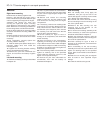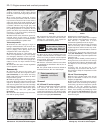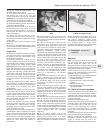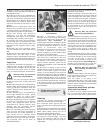
Reconnection
11 Ensure that the bush fitted to the centre of
the crankshaft is in good condition. Apply a
little Molykote G1 grease (available from your
Peugeot dealer) to the torque converter
centring pin. Do not apply too much,
otherwise there is a possibility of the grease
contaminating the torque converter.
12 Ensure that the locating dowels are
correctly positioned in the engine or
transmission.
13 Carefully offer the transmission to the
engine, until the locating dowels are engaged.
14 Refit the transmission housing-to-engine
bolts, ensuring that all the necessary brackets
are correctly positioned, and tighten them to
the specified torque setting.
15 Remove the torque converter retaining
strap installed prior to removal. Align the
torque converter threaded holes with the
retaining plate, and refit the three retaining
bolts.
16 Tighten the torque converter retaining
bolts to the specified torque setting, then refit
the driveplate lower cover.
17 Refit the starter motor, and securely
tighten its retaining bolts.
Refitting
18 Refit the engine/transmission to the
vehicle as described in paragraphs 59 to 63 of
Section 3.
19 The remainder of the refitting procedure is
a reversal of the removal sequence, noting the
following points:
a) Ensure that the wiring loom is correctly
routed, and retained by all the relevant
retaining clips; all connectors should be
correctly and securely reconnected.
b) Prior to refitting the driveshafts to the
transmission, renew the driveshaft oil
seals (see Chapter 7).
c) Ensure that all coolant hoses are correctly
reconnected, and securely retained by
their retaining clips.
d) Adjust the selector cable and kickdown
cable as described in Chapter 7B.
e) Adjust the throttle cable as described in
Chapter 4.
f) Refill the engine and transmission with
correct quantity and type of lubricant, as
described in Chapter 1.
g) Refill the cooling system as described in
Chapter 1.
5 Engine overhaul - preliminary
information
It is much easier to dismantle and work on
the engine if it is mounted on a portable
engine stand. These stands can often be hired
from a tool hire shop. Before the engine is
mounted on a stand, the flywheel/driveplate
should be removed so that the stand bolts
can be tightened into the end of the cylinder
block/crankcase.
If a stand is not available, it is possible to
dismantle the engine with it suitably
supported on a sturdy, workbench or on the
floor. Be careful not to tip or drop the engine
when working without a stand.
If you intend to obtain a reconditioned
engine, all ancillaries must be removed first, to
be transferred to the replacement engine (just
as they will if you are doing a complete engine
overhaul yourself). These components include
the following:
a) Alternator mounting brackets.
b) Engine mountings and brackets (Part A, B
or C of this Chapter).
c) The ignition system and HT components
including all sensors, distributor cap and
rotor arm, ignition module, HT leads and
spark plugs (Chapters 1 and 5).
d) Power steering pump and air conditioning
compressor brackets (where fitted).
e) Thermostat and housing, coolant pump,
coolant outlet chamber/elbow (Chapter
3).
f) Dipstick tube.
g) Carburettor/fuel system components
(Chapter 4).
h) All electrical switches and sensors.
i) Inlet and exhaust manifolds (Chapter 4).
j) Oil filter (Chapter 1).
k) Fuel pump - carburettor engines only
(Chapter 4).
l) Flywheel/driveplate (Part A, B or C of this
Chapter).
Note: When removing the external
components from the engine, pay close
attention to details that may be helpful or
important during refitting. Note the fitting
positions of gaskets, seals, washers, bolts and
other small items.
If you are obtaining a “short” engine
(cylinder block/crankcase, crankshaft, pistons
and connecting rods all assembled), then the
cylinder head, timing chain/belt (together with
tensioner, tensioner and idler pulleys and
covers) sump and oil pump will have to be
removed also.
If a complete overhaul is planned, the
engine can be dismantled in the order given
below, referring to Part A, B or C of this
Chapter unless otherwise stated.
a) Inlet and exhaust manifolds (Chapter 4).
b) Timing chain, sprockets, tensioner and oil
pump - XV, XW and XY series engines.
c) Timing belt, sprockets and tensioner - XU
and TU series engines.
d) Cylinder head.
e) Flywheel/driveplate - XU and TU series
engines.
f) Sump - XU and TU series engines.
g) Oil pump - XU and TU series engines.
h) Piston/connecting rod assemblies
(Section 7).
i) Crankshaft (Section 8).
6 Cylinder head - dismantling,
cleaning, inspection and
reassembly
3
Note: New and reconditioned cylinder heads
are available from the manufacturer, and from
engine overhaul specialists. Be aware that
some specialist tools are required for the
dismantling and inspection procedures, and
new components may not be readily available.
It may therefore be more practical and
economical for the home mechanic to
purchase a reconditioned head, rather than
dismantle, inspect and recondition the original
head.
Dismantling
1 Remove the cylinder head as described in
Part A, B or C of this Chapter (as applicable).
2 If not already done, remove the inlet and
exhaust manifolds with reference to the
relevant Part of Chapter 4.
3 Remove the camshaft, followers and shims
(as applicable) as described in Part A, B or C
of this Chapter.
4 Using a valve spring compressor, compress
each valve spring in turn until the split collets
can be removed. Release the compressor,
and lift off the spring retainer, spring and
spring seat. Using a pair of pliers, carefully
extract the valve stem oil seal from the top of
the guide (see illustrations).
5 If, when the valve spring compressor is
screwed down, the spring retainer refuses to
free and expose the split collets, gently tap
the top of the tool, directly over the retainer,
with a light hammer. This will free the retainer.
6 Withdraw the valve through the combustion
chamber (see illustration).
2D•8 Engine removal and overhaul procedures
6.4a Compress the valve spring with a
compressor and remove the split collets . . .
6.4b . . . Release the compressor and
remove the spring retainer . . .


















